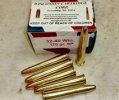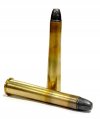richhodg66
Well-Known Member
A while back I got a rifle in .32-40, finally got around to shooting it a bit this afternoon. I do cast for this (have loaded and shot .32 Winchester Special a good bit and have several molds), I was using some I got from a guy who was selling off his Dad's stuff he wasn't going to use, plain based flat nose design about 165 grains. Using my old Lyman manual, I shot mostly Unique loads at 50 yards between six and eight grains. Data is pretty light in that manual, which is fine, unlikely I'll ever hunt with this one anyway.
I used brass formed from .30-30 brass. The best seemed to be 7.5 grains. I'm gonna play around with seating depth a bit more, and I know the brass is a tad short, but I was getting primers backing out a little, seemed like it got better the higher the charge was, they back ed out noticeably more with the lighter loads.
I'd rather not drill flash holes if I don't have to. Would switching to a powder like Bullseye help with this? Lighter or heavier bullet?
One thing, I need a taller front fight or get a tang sight for it (1899 Savage). The rifle promises to be a fun range toy, bore is good, trigger pull is pretty good. Sights aren't bad as open sights go. Gotta pursue this more as I get time.
Thoughts?
I used brass formed from .30-30 brass. The best seemed to be 7.5 grains. I'm gonna play around with seating depth a bit more, and I know the brass is a tad short, but I was getting primers backing out a little, seemed like it got better the higher the charge was, they back ed out noticeably more with the lighter loads.
I'd rather not drill flash holes if I don't have to. Would switching to a powder like Bullseye help with this? Lighter or heavier bullet?
One thing, I need a taller front fight or get a tang sight for it (1899 Savage). The rifle promises to be a fun range toy, bore is good, trigger pull is pretty good. Sights aren't bad as open sights go. Gotta pursue this more as I get time.
Thoughts?


